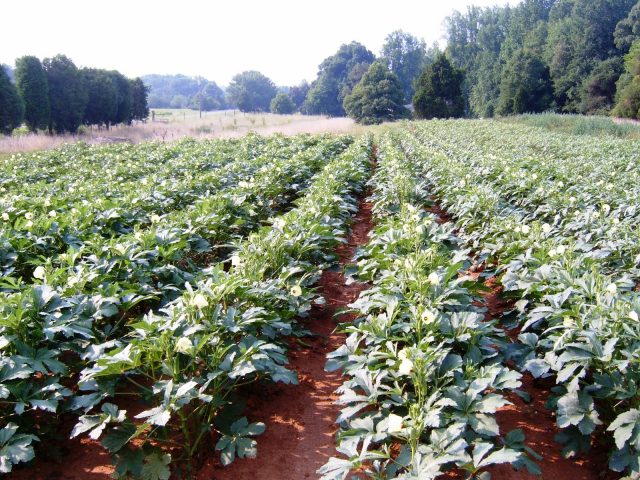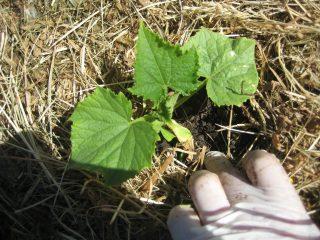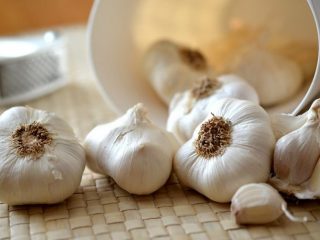Content
Edible Abelmosch or Okra (Abelmoschus esculentus) is a species belonging to the genus Abelmoschus from the Malvaceae family. The plant has many other names - lady's fingers, bhindi, okra, edible hibiscus, gumbo. They started growing okra so long ago that they can no longer accurately determine its origin. For example, there is documentary evidence that the culture was popular in Egypt 2000 BC, but some sources consider India or West Africa to be the birthplace of the species.
Most scientists define okra as a cultigen - a cultivated plant, but one that has no analogues in nature. It is believed that Agalmesh Edible was bred by man through selection.Moreover, it was a very long time ago, and it is impossible to determine whether the original species has become extinct, or whether the changes have gone so far that it is impossible to correlate wild and domesticated plants as closely related crops.
Where does okra grow?
Growing okra or lady's fingers is possible for beginner gardeners who are very busy and therefore constantly forget to water or feed the plant. If the planting site was chosen correctly, the crop is highly likely to survive and produce a harvest even if it is neglected.
What okra requires is heat and sun. If the temperature drops below 12°C at night and 15°C during the day, the crop may die. The ideal temperature range is from 20 to 30° C. Therefore, in the central zone, growing okra in open beds is possible only through seedlings. The bushes need to be placed in a well-lit place.
Okra prefers fertile, loose soil with a slightly acidic reaction, but will bear fruit in a wide range of pH readings - from 5.5 to 8. The crop loves potassium and abundant watering, but can withstand drought and lack of fertilizing.
Since okra grows wild close to the equator, it requires long daylight hours. Scientists even calculated the minimum at which the plant will bear fruit - 12 often 30 minutes.
How does okra grow?
It is noteworthy that the description of okra can be found among vegetable and ornamental plants. There are quite picturesque varieties, but ordinary ones also bloom so attractively that they have won a place in flower beds.
Okra is a herbaceous plant, depending on the variety, the height of which ranges from 30-40 cm to 2 m. The stem is juicy, thick, woody, rather fragile, especially in tall forms, and pubescent. At the base it branches into 2-7 processes.
Leaves on long petioles are palmate, with 5 or 7 lobes, pubescent. Depending on the variety, their length ranges from 10 to 20 cm, their color is green, from light to dark.
Single flowers are simple, large, 4-8 cm in diameter, usually yellow or white, often with red or purple spots at the base of the petals (there may be 7 or 8 of them). The fruit is a pentagonal capsule with slimy contents and a large number of seeds, resembling the shape of hot pepper pods, only ribbed and covered with hairs. Their length after ripening can reach 18 cm (in some varieties - 25 cm).
Varieties of okra
There are many varieties of okra, many of which are designed to grow in a specific region. Four were even included in the State Register, but in the middle zone much more can be grown, especially in greenhouses.
Most Popular:
- Star of David - distinguished by more facets than most okra varieties, thick fruits 7 cm long, purple leaves;
- Blondie - early ripening yellow-green pods 8 cm long;
- Cow Horn - okra up to 2.5 m high, with fragrant fruits 25 cm long;
- Alabama Red is often used as an ornamental plant; its dark red pods turn green when cooked;
- Clemson Spineless grows up to 150 cm, dark green fruits up to 15 cm long are hairless;
- Lady's Fingers - mid-season okra about 1 m high;
- Ballet is the newest variety, created in 2018;
- White Velvet;
- Green Velvet;
- Dwarf Green;
- Tall 100;
- White Cylindrical.
Bombay
An okra variety included in the State Register in 2013, created by Euro-Seeds LLC. Recommended for cultivation in all regions. Used fresh, frozen, canned, dried.
The ovaries weighing 9-10 g, aged 3-6 days, 8-10 cm long, up to 2 cm thick are eaten. From the moment of emergence of seedlings to the first harvest, 75 days pass. The stem is 60 cm high, the leaves are green, raised, the flowers are light yellow.
From 1 sq. m harvest 1-1.2 kg of fruit.
Vlada
The Saratov variety Vlada was accepted by the State Register in 2016. It is recommended for cultivation throughout Russia, used fresh and after heat treatment. This variety is not intended for processing.
The first harvest is harvested 65-70 days after the appearance of full shoots. The stem is 40-65 cm high, with sparse hard hairs, dark green leaves, yellowish-cream buds.
From 1 sq. meters, up to 1.3 kg of 3-6-day-old greens are collected, weighing 50-70 g, up to 20 cm long.
Juno
The okra variety Juno, created by the agricultural company Gavrish, was registered in 2005. Unlike others, it is recommended for cultivation not only on private plots, but also on small farms. Used both fresh and processed. For the winter it can be preserved, frozen, dried.
This variety is late ripening. After germination, the first crop is harvested after 90-115 days. Okra Juno is a herbaceous vine up to 2 m tall. The leaves are heart-shaped with dissected edges rather than palmate. Lemon flowers.
From 1 sq.m you can collect 3.7 kg of pods weighing 10-30 g.
Features of growing okra plants
The culture is thermophilic, but has many varieties. If you take only those recommended for cultivation in Russia, there will be no problems. Exotic varieties brought from tropical countries are unlikely to survive in the middle zone.
Growing okra in the Moscow region
Growing okra in open ground near Moscow is possible only through seedlings. Young plants are moved to the garden bed after the air and soil temperatures rise so much that they become comfortable for the crop.
It makes no sense to plant okra in greenhouses in the Moscow region - it is not such a valuable vegetable that it takes up space. In addition, if you wait a little, the culture will feel great in open ground.
Growing okra in the Urals
By and large, the average monthly temperature makes it possible to grow okra in open ground in the Urals through seedlings. But the climate there is changeable; there is a great danger that a well-established plant, which has already managed to produce a harvest, will not survive the first weather “cataclysm”.
So in the Urals, okra should be grown in a greenhouse or under a film cover. You can install arcs, stock up on film or white agrofibre, and at the first danger, protect the crop from bad weather. Just first you should think about whether the resulting harvest is worth the effort.
Growing okra in Siberia
Here, okra can only be grown indoors. The question arises: is it necessary? First, you should plant several bushes in a greenhouse and evaluate the crop, and only then occupy significant areas for it.
Firstly, okra is unusual for us; it needs to be grown for commercial purposes only after carefully studying the market, since, frankly speaking, the demand for it is insignificant. Secondly, the beauty of culture for the most part lies in unpretentiousness, which is true for the southern regions and part of the Middle Zone, but not Siberia.
When to sow okra seeds
At home, growing okra from seeds will not be difficult even for those who are wary of seedlings - such an operation, unloved by many, as picking, is omitted here. It is important to guess the time correctly. And it depends on two factors:
- climate of the region;
- varieties.
You need to calculate the timing yourself. By the time the seedlings are planted in open ground, the soil should warm up to at least 10°C, and the temperature even at night should be above 12°C.
Early varieties are planted 30 days after emergence, for late varieties the deadline is 45 days. You should not keep okra seedlings on the windowsill for any longer - they will overgrow and the fragile stem may break.
Planting okra seedlings
In the central zone, okra is grown exclusively through seedlings. You can plant seeds in the ground when the air and soil have warmed up and the likelihood of return frosts has passed. This usually happens only in June.
Considering that even the earliest varieties begin to bear fruit more than 45 days after germination, there will be little time left to obtain a harvest. It is also better to plant seedlings in greenhouses. This will prolong fruiting and shorten the time before the first pods set.
In what container to grow okra?
Okra seedlings can only be grown in peat pots - their roots are long, taprooted, and may not recover after damage.So there can be no talk of picking.
It is not advisable to even use individual plastic cups or special cassettes for seedlings. When a young plant is taken out of a container, the root is still injured, albeit slightly. But for okra, this can be fatal.
Preparing soil and seeds
To grow seedlings, you can use purchased soil specially designed for this purpose, which is poured into peat humus cups, compacted and moistened. If this is not done, the seeds first planted and then watered will fail and end up too deep. To improve germination, they are soaked for 12-24 hours in warm water.
Planting okra seedlings is done as follows: place 2-3 seeds in each cup to a depth of 2-3 cm and water. Then the containers are placed in a common tray, covered with glass or transparent film, and placed on the windowsill.
Every day the improvised greenhouse needs to be ventilated and the soil moisture checked. The preferred temperature for seed germination is the range from 18 to 21 ° C. Watering is best done by spraying with warm water from a household spray bottle.
After about 6-7 days, the first shoots should appear.
When 2 true leaves appear, leave one, the strongest sprout. The rest are cut with nail scissors at ground level.
Seedling care
Okra seedlings need plenty of watering. Keep it in a sunny place, preferably on a south-facing windowsill. If necessary, illuminate for at least 12 hours a day.
Although seedlings can do without fertilizing, it is still better to water them once with a weak solution of complex fertilizers.
Immediately before planting in open ground, young plants need to be hardened off. To do this, seedlings begin to be taken out into the street within 7-10 days. The first time the okra should stand there for 2-3 hours, then the time spent in the fresh air is gradually increased. For the last two days, the seedlings are left to spend the night outside.
How to plant okra in open ground
When the ground and air warm up, okra can be planted in open ground. The place should be sunny and protected from the wind.
Preparing the landing site
The bed is dug up at least 2 weeks before planting, and it’s even better to do this in the fall. Remove the roots of weeds and stones. Chernozem does not need improvement. Humus is added to poor soils for digging; it will improve the structure and make the soil permeable to water and air.
If for some reason it was not possible to prepare the bed in advance, water it after loosening. The soil will subside a little, and the seeds or seedlings will not sink lower than necessary.
Landing rules
If planted correctly, caring for okra will be easy. The main thing is to choose the right time and place for the garden.
Planting okra seeds
The holes are made at a distance of about 30 cm from each other. For ease of care and harvesting, they are arranged in two lines. If you plant a lot of plants, leave about 60 cm between rows.
The seeds are soaked overnight or a day, buried about 2-3 cm. Watered, mulched with peat or dry soil.
Planting okra seedlings
The seedlings are planted at the same distance as okra seeds. Only you need to not only loosen the soil, but dig holes the size of the peat pots.They should not be buried; it is enough to sprinkle the surface with 2-3 cm of fertile soil. Water generously.
Watering and fertilizing
It is specifically necessary to moisten the soil during the first 2 weeks after planting the seedlings, or a month after the emergence of seedlings. Then watering is done if there has been no rain for a long time. At the same time, it is not recommended to completely overdry the crop - this will reduce the quantity and quality of the greens.
On fertile or cultivated soils, okra is usually fertilized once at an early stage with a complex preparation. This is quite enough.
Weeding and loosening
These operations are especially important for young plants. Then, if the area is not too overgrown with weeds, weeding and loosening the soil is carried out once every 2 weeks. For greater stability, okra can be hilled.
Mulching
Generally speaking, okra does not need to mulch the soil. But it makes life much easier for gardeners - it retains moisture, prevents weeds from germinating or crust forming on the ground. For mulching, you can use mowed grass or slightly sun-dried weeds that have not had time to seed.
Topping
This procedure is optional, but recommended. When the okra reaches 40 cm, the top is cut off. This way it will produce more side shoots, the yield will increase, as will the stability of the bush.
It is recommended to tie tall varieties to a support - this way they suffer less from the wind.
Is it possible to grow okra indoors?
In the North, okra can only be grown in a greenhouse.But many gardeners do not consider it such a valuable crop to replenish the number of indoor plants. In any case, it is better to first plant a few bushes, and before starting industrial cultivation, study the market or find wholesale buyers.
The agricultural technology of okra in open and closed ground differs little. If watering and fertilizing in the greenhouse are automatic, this will not harm the crop.
When and how to harvest okra
The beginning of fruiting depends on the weather and variety. If the temperature is low, up to 20° C, then even early ripening okra will not produce the first harvest 50 days after germination.
Only young pods are eaten. In this case, it is better to focus on their age, not size. The length of the fruit greatly depends on the same temperature, watering, structure and composition of the soil. The greens are picked at the age of 3-5 days, and the earlier they are collected, the better and tastier the pods.
Leaving the pods on the plant is not recommended, as okra will dramatically reduce productivity. It’s better to give them away or throw them away if you can’t eat or recycle them. After all, okra can be frozen.
By the way, if you store the pods for longer than 1-2 days, they can age and become fibrous even in the refrigerator.
These recommendations are given to those who grow okra for fresh consumption or greens processing. But do not forget that the mature seeds of this crop are considered the best coffee substitute. So perhaps those people who would not eat okra because of the slimy contents of the young pods will enjoy a drink made from its roasted and ground grains.All over the world he is known as gombo.
When harvesting okra, you need to wear gloves - the hairs covering the pods can cause skin irritation or allergies. They are easily removed when washing the fruit.
Diseases and pests
Most often, the crop suffers from verticillium wilt - it causes the death of the plant. The problem may be:
- powdery mildew;
- leaf spot;
- rot;
- root nematodes.
Among the pests of okra, it is especially worth noting:
- aphids;
- spider mite;
- corn worm;
- slugs;
- whitefly
Since the crop is harvested at least once every 3 days, pests and diseases should not be controlled with chemical methods. It is better to use an infusion of garlic, onion peel or other folk remedies.
Reproduction
Okra is easily propagated by seeds, which remain viable for up to two years. You can collect them yourself, leaving a few of the best pods on the plant. It should be taken into account that the productivity of the bush will sharply decrease.
Conclusion
People in Russia are not accustomed to growing okra. This crop is not only new, but also not arousing delight among most gardeners; meanwhile, they simply do not know how to prepare it correctly.
















